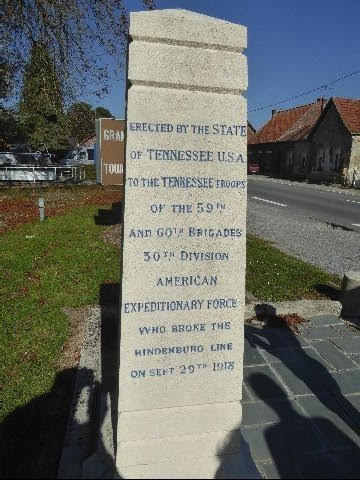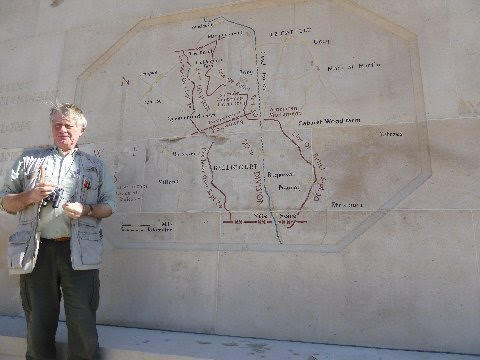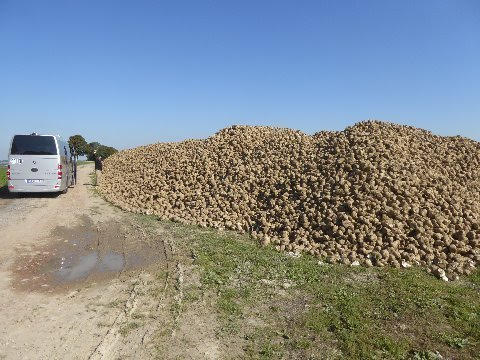Picto Diary - 01 October 2015 - Battle of St. Quentin Canal
Battle of St. Quentin Canal
The Battle of St. Quentin Canal, which began on 29 September 1918, was part of the 100 Days Allied Offensive that ended WWI.
British, Australian and American forces fought as a single combined force against the Seigfried Stellung of the Hindienburg Line. Australian, general Sr John Monash was commander.
The battle achieved all of its objectives, resulting in the first full breach by the allies of the Hindenburg Line.
Context. Spring/Summer 1918.
Russia. Ascendant Bolsheviks take Russia out of the war as of 03 March 1918 via treaty of Brest-Litovsk signed with Germans.
France. Worn and tired... but, recovering from the mutinies of Verdun in 1916. Still fighting. Field Marshall Foch is Supreme Allied Commander.
Britain. British army exceeds over 4MM troops and is a growing energy source to fight the war in the wake of French attrition and war weariness.
United States: Notwithstanding strong isolationist public opinion and Wison's campaign promise to keep America out of war, US declares war on Germany April 1917. Decoded Zimmerman telegram, where Germans sought an alliance with Mexico, the proximate cause. (Battlefield guide Patrick Mercer says the Zimmerman telegram was "doctored.")
Germany: With fighting stopped on the Eastern Front, and before feared US fighting capability matures, launches 1918 Spring Offensive as a last ditch effort to win the war.
Context. Summer/Fall 1918
Rebuffing the German Spring Offensive, the Allies launch The Hundred Days Offensive, the final period of the First World War. The final Allied thrust began with the Battle of Amiens in August 1918 and includes the Battle of St. Quentin Canal, September/October 1918, which our tour group studies today.

Above: Monument for 46th (North Midland) Division. Bellecourt, France. 01 October 2015.
In our progressive tour of British and Commonwealth WWI battlefields battlefield guide Patrick Mercer has followed the ups and downs of the 46th Division.
We first studied the 46th at the battle of Loos where they were decimated in their bloody assault on the Hohenzollern Redoubt. September 1915.
We visited Gommecourt, where on the first day of the Battle of the Somme, 01 July 1916, the 46th Division was disgraced as its commander, General Stuart-Wortley, stopped, against orders, an assault on German lines.

Above: Standing on original Riqueval Bridge over the St. Quentin Canal, battlefield guide Patrick Mercer educates 1%, Portland, and Rudy Jr. on how units of the 46th Division, on 29 September 1918, seized the Riqueval Farm bridge. Bellecourt, France. 01 October 2015.
The Riqueval Farm bridge engagement was part of the Battle of St. Quentin Canal. The bridge was the last bridge left intact across the St. Quentin Canal, an important feature of the German defenses along the Hindenburg Line. Capturing the bridge greatly assisted the forward flow of supports to complete the successful storming of the "Siegfried Position," inaugurating the last phase of the final Allied offensive which ended with the Armistice on 11 November 1918.
Redemption for the 46th!

Above: Brigadier General J.V. Campbell addresses troops of the 137th Brigade (46th Division) from the Riqueval Bridge over the St. Quentin Canal. 01 October 1918. File image.
To me this is a breathtaking image. It helps to make real the events, 97 years ago, about which we learn from Patrick Mercer as we stand on the very same bridge pictured here.
What was General Campbell saying? What were the pictured troops thinking? My mind has a hard time coming to grips with the notion that the battleground sights we are seeing on our WWI battlefield tour witnessed such conflagration.
Someone on the trip wondered if something was missing from life if you haven't physically fought for a cause. For a soldier, can the horror of war also be the apotheosis of life experience? Is there something important missing from the life experience if you haven't fought to the death and survived? Were the lives of the survivors seen in the image somehow enhanced? Ruined? Do war and human progress correlate? I don't think the answers to these questions are as easy as might seem, though in the wake of the millions of lives lost in WWI it might seem easy to make the case that there is no correlation.

Above: Battlefield guide Patrick Mercer's hand drawn schematic used for explaining to our group The Battle of St. Quentin. 01 October 2015.
Patrick's prodigious knowledge of the WWI battlefields and his, obvious, diligent preparation, turns what would otherwise be a tour of beautiful Belgian and French Flemish farmlands into a first row seat at a seminal historic event, which almost like none other event in world history, shaped the world in which we live today.
A qualified battlefield guide and historian makes all the difference on a trip like this. We have one.

Above: Tunnel entrance, St. Quentin Canal, Bellecourt, France. 01 October 2015.
In image, 1%, Portland, Rudy Jr., battlefield guide Patrick Mercer, and the Bishop.
St. Quentin Canal was commissioned by Napoleon I, linking the canalized Escaut River in Cambrai to the Canal Lateral a Oise and the Canal de Oise a L'Aisne in Chauny.
The canal, was a natural obstacle along the Hindenburg Line in WWI, goes underground into the tunnel at Bellecourt and exits four miles to the north.

Above: Looking west from memorial at American Somme cemetery. Bony, France. 01 October 2015
The memorial is directly over the mid-point of the underground portion of the St. Quentin Canal.
This is where (also Riqueval Bridge to the south) American, British, and Australian troops, beginning 29 September 1918 participated in a spearhead attack as a single combined force against the Germans along the Hindenburg Line.
The assault achieved its objectives resulting in the first full breach of the Hindenburg Line in WWI, in the face of heavy German resistance and, in concert with other attacks of the 100 Days Offensive along the length of the line. After the allied 1918, September attacks, bolstered by the fresh and eager doughboy troops, the Germans capitulated and sued for peace. The Armistice was signed on 11 November 1918.

Above: Monument to American Troops who fought in the Battle of St. Quentin. Bellecourt, France. 01 October 2015
Our trip has been organized to see battlefields where British/Commonwealth troops fought during WWI.
Still, it is fitting we end our battle field tour at a battleground where American troops fought along side with British and Australian troops late in the war.

Above: Terrines for lunch at buffet in Bellecourt cafe. 01 August 2015.
Lunch at an otherwise Spartan looking place on an isolated corner in Bellecourt was the best lunch on the trip.
In addition to the tasty terrines, shown above, were thistle artichokes in oil, couscous, coleslaw, hard boiled eggs, a local fish, and obligatory French fries.

Above: Former US Marine, 1% stands in Somme American Cemetery, Bony, France. 01 October 2015.
1%, some family members, and some friends (including Mwah [sic]) are on a tour of WWI battlefields in Belgium and France, reviewing the WWI principally from the British point of view. The Battle of St. Quentin is the only American WWI site we will visit as we complete our tour today.
Almost directly under the cemetery is the St. Quenton Canal, running left (south) to right (north) in the image.

Above: Battlefield guide Patrick Mercer, OBE, former British soldier, Member of Parliament, and author, stands near engraved schematic of Battle of St. Quentin on memorial at Somme American Cemetery. 01 October 2015.

Above: Rudy Jr. stands near recently harvested sugar beets. Bellecourt, France. 01 October 2015.
A sub theme of our trip could have been "large scale agriculture in northern France."
WWI battlefield trip epilogue to follow.
Addendum:
Thank you, Steve. The image itself seems to have been badly distorted during download but no matter.
As I heard almost sixty years ago, when I first read about WW-I, it's worth remembering that it came to an end largely because of "the collapse of the Macedonian Front" - the reason the German High Command gave the Kaiser when he asked why Germany had to sue for peace, as they were then urging. In September 1918, the almost-forgotten Allied "Army of the East" attacked through mountain passes considered impregnable, with such effect that Bulgaria capitulated. Allied forces could have driven straight up to Berlin - stopping them would have been only by withdrawing troops from the front in France, where of course the Allies - including the newly arrived Americans - had successfully withstood Ludendorf's offensives and had gone on to counter-attack, as you mention.
The WW-I fighting in the Balkans is in danger of being almost forgotten. There were years of almost inaction in that theatre, but as mentioned above it ended with a smashing victory - such a major one that it brought the war to an end.
Interestingly, that area is where Britain's only woman soldier in World War I fought. Her name was Flora Sandes (Irish, born in Yorkshire; her father was a clergyman). Flora was a volunteer ambulance driver who enrolled in the Serbian Army (after being separated from her ambulance and her volunteer unit during the fighting). As a Serbian soldier she rose to become a Sergeant Major, was severely wounded (by a grenade) in combat, but recovered (and was decorated). She retired with a post-war promotion to Captain. Strangely, Hollywood never made Flora's story into a movie. She may not have been an American but the ambulance unit she volunteered with had been raised and led to Serbia by an American, Mabel Dunlop. There's surely another great story there.
Cheers,
Cheeta,
Vancouver, BC
Hmmm . . . You feign concern about wind turbines killing birds, but ignore the massive bird kills by cats and the serious threat to entire bird species from climate change:
Earlier this month, a National Audubon Society report said that hundreds of bird species in the U.S. — including the bald eagle and eight state birds, from Idaho to Maryland — are at "serious risk" due to climate change. It said some species are forecast to lose more than 95% of their current ranges.
http://www.usatoday.com/story/money/business/2014/09/15/wind-turbines-kill-fewer-birds-than-cell-towers-cats/15683843/
Your predilection for fossil fuels seems to have induced a fossilization of critical thinking. Let's hope it's temporary.
Best wishes for a prompt recovery.
FeeNix,
Phoenix, AZ

Great reading Steve.
Got back last night from bike meet 200km northwest of Tokyo. Spent a couple of nights at spa in the mountains, 2000 meters up. Took the 'elephant' sidecar, all 50cc of 2-stroke Honda. 1st or second gear up the 14km climb. Well, if Hannibal can do it so can I!!!
Malc,
Tokyo, Japan
What a beautiful job you do on history Thank you.
LaDoc and LaPsy,
Los Angeles, CA
Dear Steve,
This is an excellent description of one aspect of the War to end all Wars. Thanks for sharing it.
I wonder, of the 420,000 British casualties suffered at the Somme, does anyone know how many came from the Empire: Australia, Canada, India, New Zealand, South Africa, East Africa and so on? They made a huge contribution during the war.
Not surprisingly, it was the Germans who developed new strategies, tactics and weapons to avoid another war of static attrition. Blitzkrieg. Concentration of overwhelming force on a narrow front followed by rapid movement and envelopment.
Ciao
Bosco
Steve, I just wanted to thank you for taking the time and writing your blog. I am a big World War follower and your recent emails have been great.
best,
Phil,
Anchorage, Alaska
Just saw the first episode of Our World War on Netflix. The first episode is about the Battle of Mons, specifically the heroic actions of Dease and Godley at the bridge.
Rudy, Jr.
Salt Lake City, UT